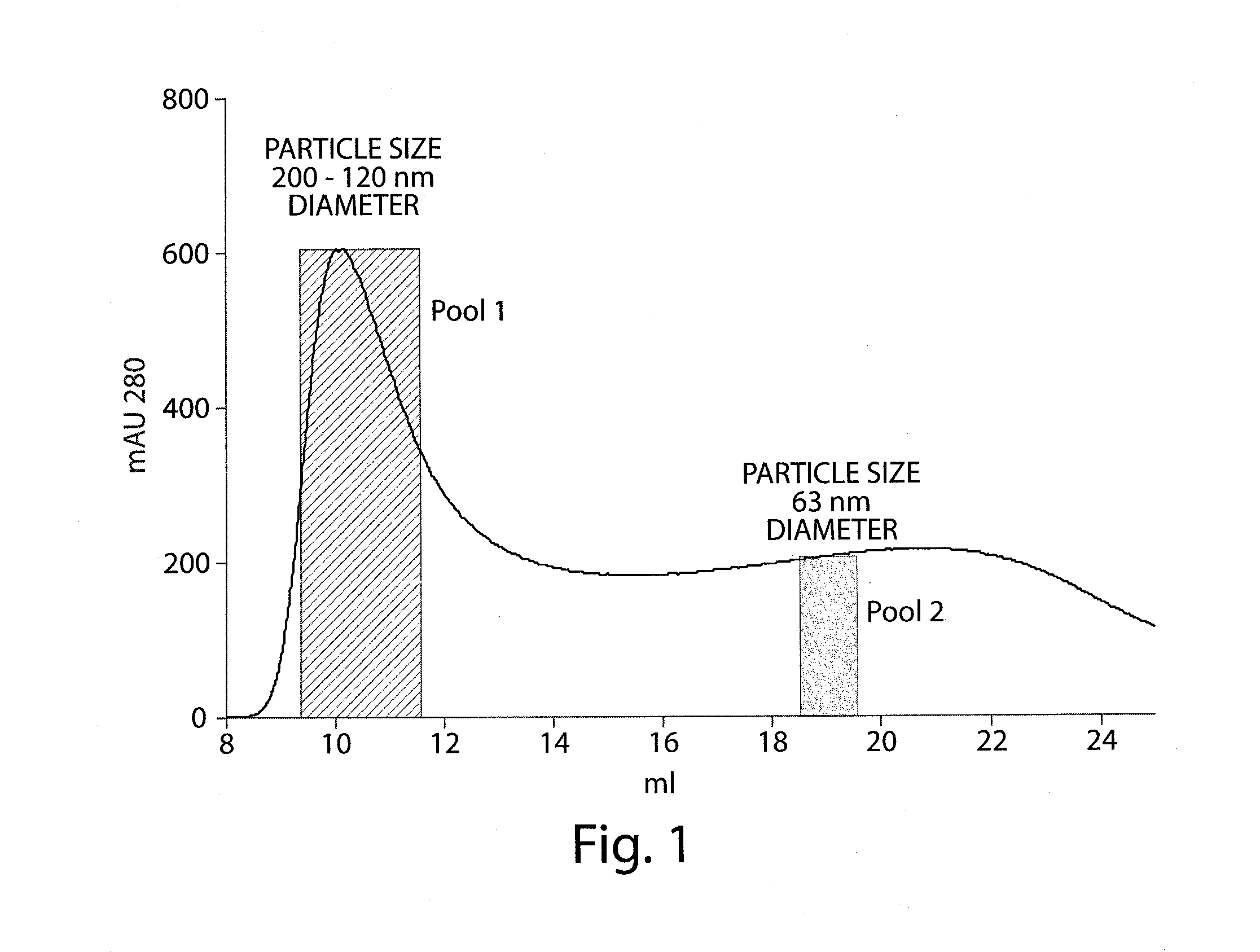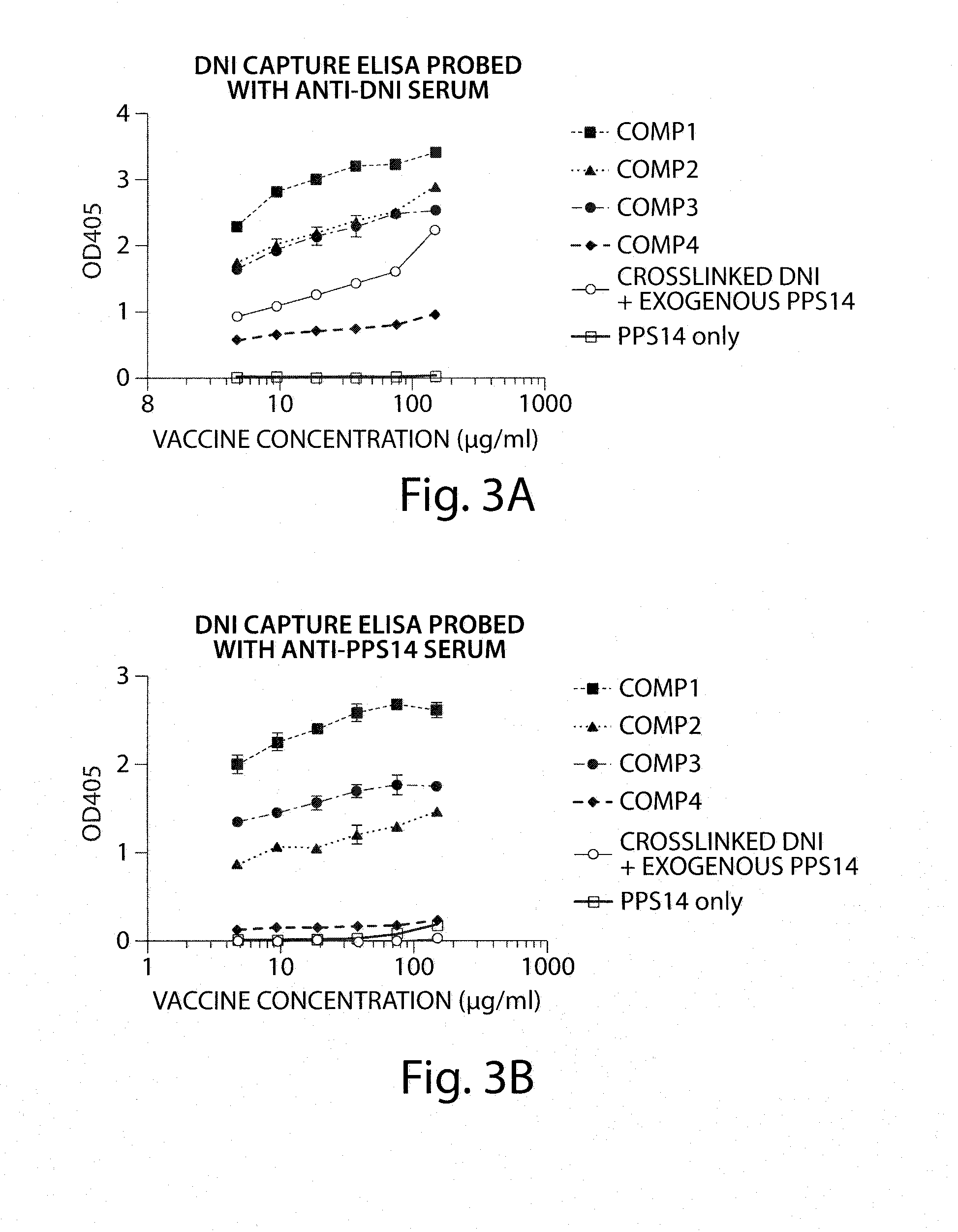Protein matrix vaccines of improved immunogenicity
- Summary
- Abstract
- Description
- Claims
- Application Information
AI Technical Summary
Benefits of technology
Problems solved by technology
Method used
Image
Examples
example 1
[0135]The effect of particle sizing on a matrix vaccine composition was investigated using as an antigen S. pneumoniae polysaccharide type 14 capsular polysaccharide (PPS-14) and using as a carrier protein the dominant negative mutant (DNI) form of B. anthracis protective antigen (PA) expressed from Escherichia coli as described by Benson et al. (Biochemistry, 37:3941-3948 (1998)).
[0136]The polysaccharide antigen (PPS 14) and carrier protein (DNI) were mixed at a 1:1 weight ratio and were present at 7.5 mg / ml for each component. Crosslinking of the DNI carrier protein was initiated by adding glutaraldehyde as a crosslinking agent. Two crosslinking reaction mixtures were made up: one having a final glutaraldehyde concentration of 0.05% and one having a final glutaraldehyde concentration of 0.25%. The crosslinking reaction was carried out in a total volume of 0.5 ml by incubating at 4° C. for 23 hours. At that time, sodium cyanoborohyride, which reduces Schiff bases, was added to a co...
example 2
[0152]A matrix vaccine composition was prepared using as an antigen Salmonella typhi polysaccharide antigen Vi (extracted from Salmonella enterica serovar Typhi strain Ty2) and using as a carrier protein the dominant negative mutant (DNI) form of B. anthracis protective antigen (PA) expressed from Escherichia coli, to make Vi:DNI protein capsular matrix vaccine (Vi:DNI PCMV). The polysaccharide antigen (Vi) and carrier protein (DNI) were mixed at a 1:1 weight ratio and were present at 7.5 mg / ml for each component. Crosslinking of the DNI carrier protein was initiated by adding glutaraldehyde as a crosslinking agent to a final glutaraldehyde concentration of 0.25%. The crosslinking reaction was carried out in a total volume of 0.5 ml by incubating at 4° C. for 23 hours. At that time, sodium cyanoborohyride, which reduces Schiff bases, was added to a concentration of 20 mg / ml and the reaction mixture was incubated an additional hour. A portion of the reaction mixture was applied to a ...
example 3
[0162]A further experiment on a size fractionated PPS 14:DNI protein capsular matrix vaccine was conducted, following the protocol of Example 1 but on a larger scale. A polysaccharide antigen (PPS 14) and carrier protein (DNI) were mixed at a 1:1 weight ratio and were present at 7.5 mg / ml for each component. Crosslinking of the DNI carrier protein was initiated by adding glutaraldehyde as a crosslinking agent to a final glutaraldehyde concentration of 0.25%. The crosslinking reaction was carried out in a total volume of 1.5 ml by incubating at 4° C. for 23 hours. At that time, sodium cyanoborohyride, which reduces Schiff bases, was added to a concentration of 20 mg / ml and the reaction mixture was incubated an additional hour.
[0163]A portion of the PPS 14:DNI PCMV reaction mixture was applied to a 100 ml Sepharose® CL-2B crosslinked agarose gel size fractionation column (Sigma-Aldrich) to separate the PPS 14:DNI matrix vaccine composition based on particle size. Fractionation was car...
PUM
| Property | Measurement | Unit |
|---|---|---|
| Fraction | aaaaa | aaaaa |
| Force | aaaaa | aaaaa |
| Diameter | aaaaa | aaaaa |
Abstract
Description
Claims
Application Information
 Login to View More
Login to View More - R&D
- Intellectual Property
- Life Sciences
- Materials
- Tech Scout
- Unparalleled Data Quality
- Higher Quality Content
- 60% Fewer Hallucinations
Browse by: Latest US Patents, China's latest patents, Technical Efficacy Thesaurus, Application Domain, Technology Topic, Popular Technical Reports.
© 2025 PatSnap. All rights reserved.Legal|Privacy policy|Modern Slavery Act Transparency Statement|Sitemap|About US| Contact US: help@patsnap.com



